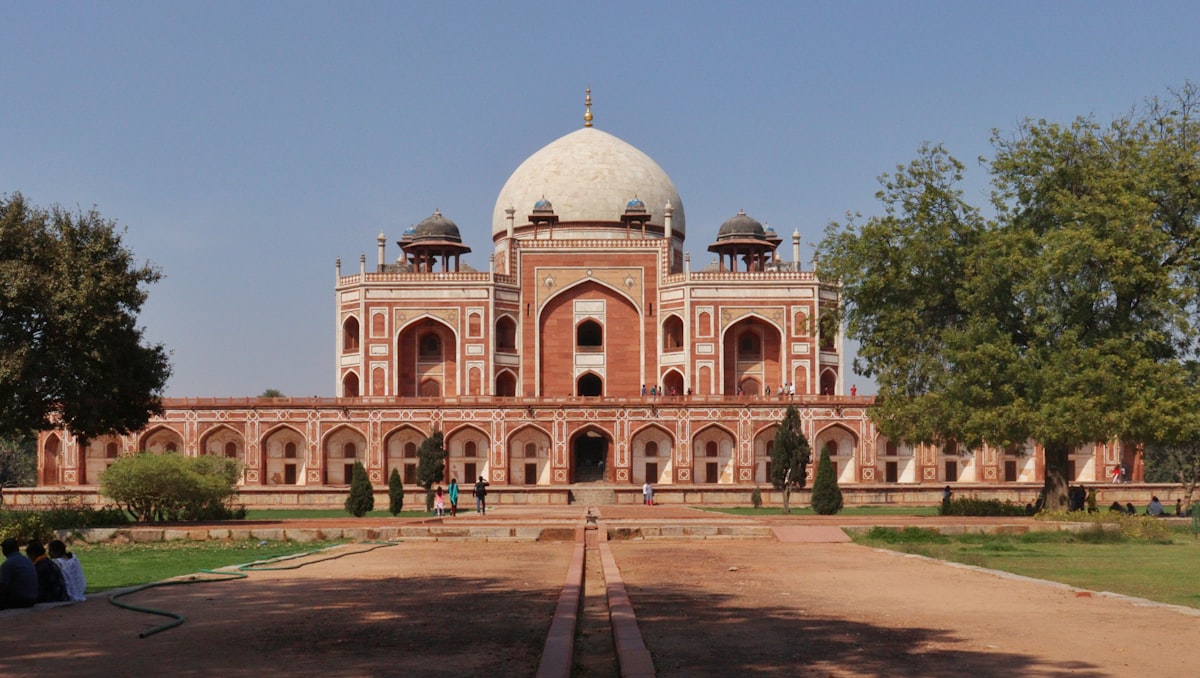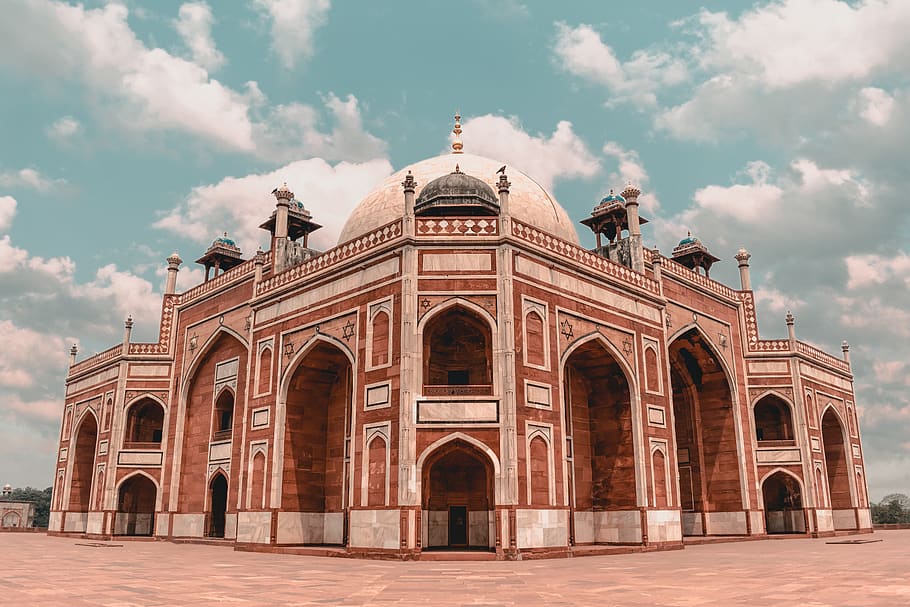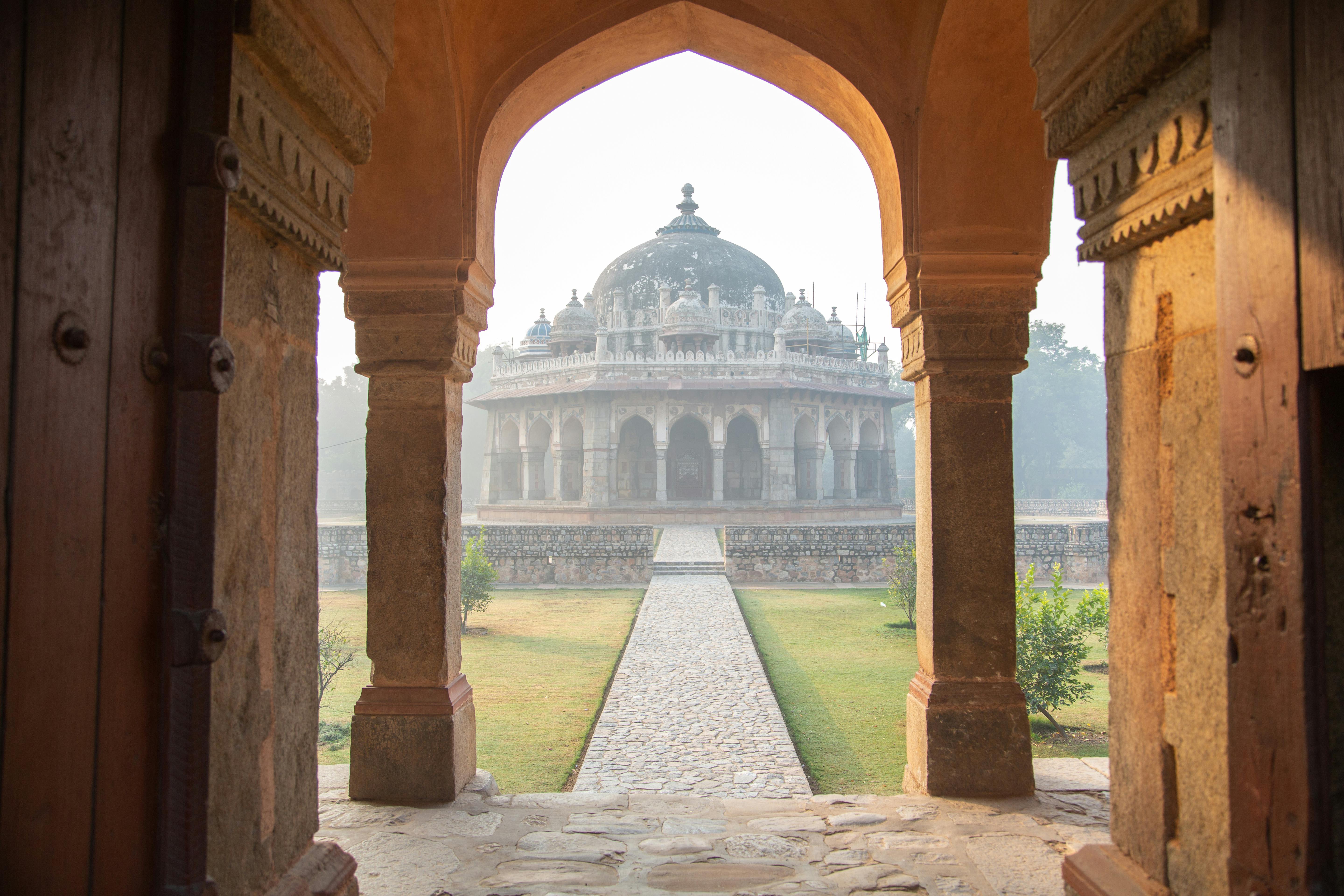
With its Persian-style gardens, red sandstone build, and rich history, Humayun's tomb draws heritage enthusiasts, culture lovers, and photographers from around the world.
Whether you're visiting for the first time or returning to explore its deeper stories, this guide has you covered—from ticket prices and history to what’s inside the complex, nearby food options, and how to make the most of your visit with guided tours.
Contents:

Quick Visitor Information
Where is Humayun’s Tomb located?
Humayun’s Tomb is located in Nizamuddin East, Delhi, just a short drive from India Gate and well-connected via the JLN Stadium Metro Station (Violet Line). It sits within a garden complex surrounded by other important Mughal-era monuments.
Which metro station is nearest to the Tomb?
Both JLN Stadium (Violet Line)—1.6 kms west, and Hazrat Nizamuddin (Pink Line)—2.3 kms east, are close to Humayun's Tomb. From the metro station, you can easily hire an auto-rickshaw or taxi or even walk (approximately 15-20 minutes).
What is the best time to visit?
The ideal time to visit Humayun's Tomb is between September and March, when Delhi experiences cool and pleasant weather. To enjoy a peaceful and unhurried visit, we highly recommend arriving early in the day and aiming to conclude your exploration before 11:00 AM.
In summers, you can opt for the night visit. The Complex is brilliantly lit after sunset.
How much is the entry fee?
For Indian citizens and nationals from SAARC countries (Afghanistan, Bangladesh, Bhutan, Maldives, Nepal, Pakistan, and Sri Lanka), the entry fee is ₹35. Foreign nationals are charged ₹550. Entry is free for children below 15 years of age. See our full Humayun’s Tomb Ticket Guide for helpful tips and booking links.
What are the opening hours?
The tomb is usually open daily from sunrise (around 6:00 AM) to sunset (approximately 6:00–6:30 PM). Recently, the opening hours have been extended to 9:00 PM to promote night tourism in Delhi. Entry may be restricted on certain national holidays or during special events.
The best time to visit is early morning or late afternoon for pleasant weather and fewer crowds.

How long does it take to see Humayun's Tomb?
It can take 90-120 minutes to see all the main attractions inside the complex. Apart from the main tomb, there are numerous other buildings like Arab Sarai Gate, Isa Khan's Tomb, and Bu Halima garden.
What should I wear when visiting?
Though Humayun’s Tomb is not an active religious site, modest and respectful clothing is still encouraged. Opt for light cotton attire during Delhi’s hot months and a jacket or shawl during winter mornings. Comfortable walking shoes are highly recommended, as the complex is large and includes uneven stone paths and grassy walkways. Keep sunglasses, sunscreen, or an umbrella, as there’s limited shade in the garden areas.
What amenities are available inside the complex?
Humayun's Tomb offers a few basic amenities for visitors:
Restrooms: Clean restrooms are available within the complex
Snack Vendors: You will find small snack vendors selling refreshments and light snacks near the entrance
Accessibility: Most parts of the tomb are wheelchair accessible
What else should I keep in mind before visiting?
Bring a valid ID (passport for foreign nationals), and keep your entry ticket accessible throughout your visit—security may ask to check it upon entry and exit. Large bags and outside food are discouraged, and while cloakrooms may be available, it’s best to travel light.
History of Humayun’s Tomb
Situated in the heart of Delhi, Humayun’s Tomb is the resting place of Humayun, the second Mughal Emperor. It was commissioned around the year 1565 either by Humayun's chief consort, Bega Begum, or son and successor, Akbar, and was designed by Persian architect Mirak Mirza Ghiyas. Beyond its beauty, the tomb complex served as a template for later Mughal monuments and houses the graves of over 100 Mughal royals, making it a resting place of emperors and a symbol of dynastic power.
What makes Humayun’s Tomb so famous?
Humayun’s Tomb is celebrated as a pioneering example of Mughal architecture in India. It was the first garden tomb in the Indian subcontinent and marked the beginning of the architectural style that would later culminate in the Taj Mahal. Its charbagh (four-part garden), central dome, and symmetrical layout reflect Persian influences blended with Indian craftsmanship.
📌 Further read: See our in-depth historical guide to Humayun’s Tomb and its architectural legacy
What to See & Do at Humayun’s Tomb
What is there to see inside the complex?
Humayun’s Tomb is more than just a single monument—it’s a heritage complex dotted with Mughal-era structures, serene gardens, and lesser-known tombs. Here are some must-see highlights:
Humayun’s Tomb (Main Mausoleum): Centerpiece of the complex, this majestic red sandstone structure houses the tomb of Emperor Humayun. It features a high double dome, arched facades, and lattice windows showcasing early Mughal architecture at its finest.
Charbagh Gardens: Persian-style quadrilateral gardens divided by walkways and water channels, representing the Islamic concept of paradise. The layout inspired the garden designs of later Mughal tombs, including the Taj Mahal.
Isa Khan’s Tomb: Located near the entrance, this octagonal tomb predates Humayun’s and is surrounded by a walled enclosure with a mosque. Often overlooked by visitors, it’s a rare example of pre-Mughal Afghan architecture.
Barber’s Tomb (Nai-ka-Gumbad): A small but elegant tomb located near the main pathway. Legend has it that it is the resting place of Humayun’s royal barber (likely untrue!).
Bu Halima’s Garden and Tomb: Little is known about Bu Halima, but her tomb and adjoining garden mark the starting point of your walk through the complex. It’s worth a brief stop for its quiet charm.
Arab Sarai Gateway: To the east of the main tomb lies the impressive gateway to the Arab Sarai, once used to house Persian craftsmen.

Is there a walking route to follow inside the complex?
Yes, planning a route will make your visit much more rewarding. The layout is linear and simple to navigate, but here’s a suggested route for a comprehensive visit:
Start at Isa Khan’s Tomb, located just to the right of the entrance
Then enter Bu Halima’s Tomb and Garden
Pass by Arab Serai and proceed to the Charbagh gardens
Enter the Main Tomb of Humayun from the south
End at the Barber’s Tomb
Exploring the whole complex in detail can take up to 2.5 hours, so plan accordingly.

Is there food and drink available to buy at Humayun’s Tomb?
There are no food or drink vendors inside the Humayun’s Tomb complex to preserve the heritage environment. Eating is not allowed within the monument area. However, water bottles are permitted, and it's wise to carry your own, especially during summer visits.
For snacks or meals, you’ll find a few local cafés and restaurants near the entrance or in nearby areas like Nizamuddin and Khan Market.
Can I take photos inside Humayun’s Tomb?
Yes, photography for personal use is allowed throughout the complex, and the site is a favorite among amateur and professional photographers alike. However, tripods, drones, and commercial equipment are not permitted without prior approval from the Archaeological Survey of India. Photography inside tomb chambers may be limited in low light, and flash use is discouraged.
Best Photo Spots
For postcard-worthy shots, don’t miss these iconic angles:
The Central Axis

Corner Arches

Lattice Screens Inside the Main Chamber
Isa Khan's Tomb

Exploring with a Guide
You’ll find licensed guides near the entrance of Humayun’s Tomb, often wearing badges. While some guides offer rich insights and engaging storytelling, others may provide only surface-level information. Foreign visitors are sometimes quoted ₹800–₹1,500 depending on the length of the tour and language preference—it’s a good idea to ask a few questions and negotiate before committing.
For a more flexible and affordable option, consider using the Tourismo self-guided audio tour. It works offline and syncs with your location at each spot within the Humayun complex. You can pause, skip, or revisit points of interest at your preferred pace.
Other Attractions Near Humayun’s Tomb
The area surrounding Humayun’s Tomb is full of historical and cultural gems, many within walking distance or a short drive away:
Sunder Nursery (5 min walk)
A beautifully restored 90-acre heritage park adjacent to the tomb complex, featuring Mughal monuments, themed gardens, and picnic spots. Great for families and nature lovers. See our Sunder Nursery guide for more details.

Humayun Site Museum (5 min walk)
A compact but informative museum showcasing Mughal-era artifacts, architectural fragments, and the history behind the tomb’s restoration—ideal for context before or after your visit.
Nizamuddin Dargah (15 min walk)
One of the most revered Sufi shrines in India, this spiritual site is dedicated to Hazrat Nizamuddin Auliya.

Khan-i-Khanan’s Tomb (5–7 min drive)
A lesser-known tomb of poet and Emperor Akbar's general Abdul Rahim Khan-i-Khanan.











